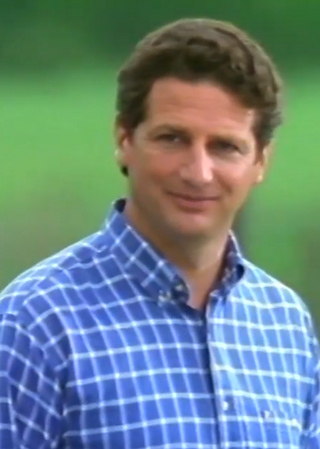
Carlos Saúl Menem was an Argentine lawyer and politician who served as the President of Argentina from 1989 to 1999. Ideologically, he identified as a Peronist and supported economically liberal policies. He led Argentina as president during the 1990s and implemented a free market liberalization. He served as President of the Justicialist Party for thirteen years, and his political approach became known as Federal Peronism.
The politics of Argentina take place in the framework of what the Constitution defines as a federal presidential representative democratic republic, where the President of Argentina is both Head of State and Head of Government. Legislative power is vested in the two chambers of the Argentine National Congress. The Judiciary is independent as well as Executive and the Legislature are independent. Elections take place regularly on a multi-party system.
The Front for a Country in Solidarity was a center-left political coalition in Argentina. It was formed in 1994 out of the Broad Front, which had been founded mainly by progressive members of the Peronist Justicialist Party who denounced the policies and the alleged corruption of the Carlos Menem administration; the Frente joined with other dissenting Peronists, the Unidad Socialista and several other leftist parties and individuals. Its leading figures were José Octavio Bordón, Carlos "Chacho" Álvarez and Graciela Fernández Meijide.

Argentina held a presidential election on Sunday, 27 April 2003. Turnout was 78.2%. No one presidential candidate gained enough votes to win outright, but the scheduled runoff was cancelled when former president and first-round winner Carlos Menem pulled out, handing the presidency to runner-up, Santa Cruz Province Governor Néstor Kirchner of the Front for Victory. Legislative elections were held on 12 dates, 27 April, 24 August, 31 August, 7 September, 14 September, 28 September, 5 October, 19 October, 26 October, 9 November, 16 November and 23 November.

Carlos Alberto "Chacho" Álvarez is an Argentine politician. He was Vice President of Argentina during the first 10 months of President Fernando de la Rúa's term, and headed the ALADI Secretariat from 2011 to 2017.

Rosa Graciela Castagnola de Fernández Meijide, better known as Graciela Fernández Meijide is an Argentine teacher, human rights activist and politician. She came to prominence by investigating the forced disappearances of thousands of people during the Dirty War. She later served as a deputy, senator, and government minister for the FrePaSo party.

José Octavio Bordón is an Argentine politician and diplomat. He was governor of Mendoza Province from 1987 to 1991, and served in both houses of the National Congress as a National Deputy and a National Senator. Most recently, he was the Argentine ambassador to the United States from 2003 to 2007 and to Chile from 2016 to 2019.

Álvaro Carlos Alsogaray was an Argentine politician and economist. He was Minister of Economy and was the principal proponent of classical liberalism in Argentina.
The Alliance for Work, Justice and Education, also known as Alliance was a centre-left political coalition in Argentina around the turn of the third millennium. It was born of the alliance of the Radical Civic Union, the Front for a Country in Solidarity and a number of smaller provincial parties in 1997. In aftermath of the December 2001 riots, the Alliance soon disintegrated, its members returning to their former parties or finding new ones.

The Argentine general election of 1995 was held on 14 May. Voters chose both the President and their legislators and with a turnout of 82.1%.

Argentina held presidential elections on 24 October 1999. Legislative elections were held on four dates, 8 August, 12 September, 26 September and 24 October, though most polls took place on 24 October.

The Argentine general election of 1983 was held on 30 October and marked the return of constitutional rule following the self-styled National Reorganization Process dictatorship installed in 1976. Voters fully chose the president, governors, mayors, and their respective national, province and town legislators; with a turnout of 85.6%.

The Argentine general election of 1989 was held on 14 May 1989. Voters chose both the President and their legislators and with a turnout of 85.3%, Carlos Menem won the presidency, and the peronist Justicialist Party won the control of both houses of Congress. This is the last presidential election the president was elected by the electoral college.

The Argentine legislative elections of 1991 were held on four dates, 11 August, 8 September, 27 October and 1 December, though most polls took place on 8 September. Voters chose their legislators and governors and, with a turnout of 80%.
The Argentine legislative elections of 1993 were held on 3 October. Voters chose their legislators and, with a turnout of 80.3%.

The Integration and Development Movement is a developmentalist political party founded by Arturo Frondizi in Argentina. It is member of Juntos por el Cambio.

Horacio Massaccesi is an Argentine politician and former Governor of Río Negro Province.

Margarita Stolbizer is an Argentine lawyer and politician. Originally a member of the Radical Civic Union (UCR), she founded her own party, Generation for a National Encounter (GEN) in 2007. She has been a member of the Chamber of Deputies of Argentina on three occasions: from 1997 to 2005, from 2009 to 2017, and since 2021.

Raúl Alfonsín was the president of Argentina from 1983 to 1989.

Carlos Menem was president of Argentina from 1989 to 1999.















